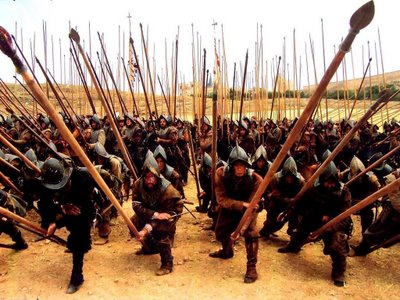
The 80 Years War Part I
Background and Causes

The 80 Years War is one of the main episodes in the Spanish war history, since the money to finance such a long war finally contributed to sink and impoverish Spain's economy and bury it under debts.
Charles V was born in Ghent in 1500 and was raised in Flanders, which in title belonged to him. For this reason the Netherlanders saw him as a their monarch. However in 1556 Charles abdicated in favor of his son, Philip II, who unlike Charles, was raised in Spain. The Dutch saw him as a foreigner. The old king had spoken flemish as well as the Spanish language. Philip, on the other hand was not even able to speak to his subjects in their own tongue. Flanders' position was of strategic importance to the Spanish crown, since it bordered with France and was very close to England.
While Charles V reigned, Calvinism had appeared in the Low Countries. Charles was Emperor of the Sacred Roman Germanic Empire, and as such was a catholic, so he had done all in his hand to repress the new religious current. His son Philip continued with the same line and forbid religious freedom, angering the Dutch nobility and calvinists and went as far as to trying to establish the Inquisition in Flanders.
On the other hand the war between Russia and Sweden closed trade and the wheat imports, coming from the Baltic sea, which caused the fall of commerce and salaries, lack of food, and the subsequent increment of its prices. The Calvinist criticized church's wealth and luxuries when the population began to go hungry. In 1566 a high increase in food prices provoked an uprising among the people. The Spanish summer camp in the Flanders was over.
Rebellion in Flanders
In 1556 the nobility of Netherlands presents a formal complaint to Margaret de Parma, Governor of of the Low Countries and sister of the Spanish king. The demanded the Inquisition's abolition and respect for religious freedom. On August 15 the calvinists assault the catholic churches, destroying the images of the saints they considered heretics. The Spanish course of action was to send Fernando Álvarez de Toledo, the Duke of Alba to Flanders with an army to repress the rebels.

The Duke of Alba took a year to reach the Netherlands, but in the meanwhile Margaret had managed to control the situation, overpowering the rebellion and at the same time informing her brother. When the Duke finally arrived she resigned as an expression of her disagreement with the King's policies. To make matters worse the Duke of Alba created in 1567 the Council of Troubles, also known as the Council of Blood (Bloedraad), which sentenced hundreds of Netherlanders to death and later confiscated their properties.
In 1568 things didn't improve, the Duke of Alba summoned the Dutch nobility under the excuse of informing them of the King's orders. But it was a trap. The counts Egmont and Horn are arrested, two nobles who had rendered services to the king. They would later be beheaded in Brussels' Grand Place. William of Orange, who would become one of the most important leaders of the rebellion, took refuge in Germany.
The 80 Years War begins
The initial military movement is known as the Battle of Heiligerlee, and it took place on May, 1568. The victory was for Louis of Nassau, brother of William of Orange (also known as William the Silent), against the imperial troops. But Louis would be soon defeated by the the Duke of Alba's forces in the Battle of Jemmingen, which pretty much destroyed the Dutch armies.

William of Orange was forced to take refuge in Germany. The Spanish school of thought was that he had crushed the rebellions and the Duke of Alba urged Philip II to travel to Flanders, so he could play the role of the merciful king. Whether the king could not or would not travel to Flanders is not known, but he left the Duke of Alba alone in his part of repressor. To make matters worse the subsidies sent by the Spanish crown to finance the armies were stolen by the English corsairs and the Duke collected taxes in Flanders to defray his army. Being forced to fund a foreign army was too much for the Netherlanders, specially since this army was used to repress them.
In 1572 there were some invasion attempts which the Duke had to face, the Geuzen, or Beggars (a confederacy of Calvinist nobles who opposed the Spanish reign in the Netherlands) took over the city of Brielle and then the ports Flesinga and Enkhuizen, closing the exit to the sea of the wealthiest provinces of the Low Countries: Holland and Brabant.
The Watergeuzen's success (Sea Beggars) rekindled the thirst for rebellion. Cities such as Holland, Utrecht and Zeeland claimed William of Orange's presence, who returned from the north leading an army. His brother Louis of Nassau commands another that attacks from the south. The Duke of Alba defeated Louis' army, that was blockading Mons, while in the north his Don Fadrique sacked the cities of Malinas, Zutphen and Naarden murdering most of their population.
Haarlem was also besieged, but the people decide to pay 250,000 florins to escape pillage and death. Finally the Duke of Alba decided to blockade Aklmaar, whose citizens decide to shatter their dykes. They knew the cost: it would be their ruin of their city, but it would also force the Duke to lift the siege.
Philip decided to replace the Duke of Alba as Flanders' governor to attempt a negotiation out of the conflict. It seemed like the Spanish had learnt his lesson, unfortunately, the war know as the 80 Years War was not over yet.
If you want to continue reading about the 80 Years War, go to Part II, or if go to the summary if you prefer a shorte version.
